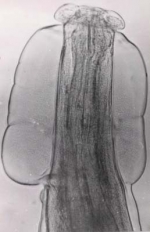NEIHPID
North-East India Helminth Parasite Information Database
Recently added
Parasites
Molecular Data
Oesophagostomum (Bosicola) radiatum (Travassos et Vogelsang Travassos et Vogelsang)
Taxonomy
Nematoda »
SECERNENTEA »
Chabertiidae (Popova, 1952) Lichtenfels, 1980 »
Oesophagostominae Railliet, 1916 »
Oesophagostomum Molin, 1861 »
Oesophagostomum (Bosicola) radiatum, Travassos et Vogelsang 1932
Synonyms
(Bosicola tricollaris Sandground, 1929)
Host
Bos (indicus)
Habitat
Small intestine
Locality
Shillong (Meghalaya), Nongstoin (Meghalaya)
Description
General
Medium-sized worms; anterior end bent like hook. Cephalic inflation well developed, with narrow annular constriction behind its middle, limited behind by prominent cervical groove which runs completely around neck and extends further back dorsally and ventrally, forming dorsal and ventral cuticular flaps. Lateral alae well developed, beginning at cervical groove, extending throughout almost whole length of body. Cervical papillae quite prominent situated at middle of oesophagus, little behind posterior limit of cephalic inflation. External corona radiata absent; internal corona radiata comprising about forty elements, represented by a ring of small denticles at anterior border of buccal capsule; buccal capsule shallow, cylindrical, slightly wider in front than behind. Oesophagus club shaped, its funnel well developed.
Male
Body 9.7- 12.4 mm long, 0.20-0.23 mm in maximum width. Bursa well developed; ventral ray cleft; medio-lateral and postero-lateral rays closely applied to each other, somewhat divergent from antero-lateral rays; externo-dorsal originating high up on main stem of dorsal; dorsal divided into two divergent terminal branches, each of which gives off a short lateral twig. Spicules equal, alate. Gubernaculum present.Â
Female
Body 13.2-14.9 mm in length, 0.29-0.34 mm in maximum width. Posterior end slightly curved ventrally; tail straight, tapering to sharp point, provided with one pair of small papillae little anterior to its tip. Vulva rather prominent, situated in front of posterior end; uterine branches parallel. Vagina very short, transverse, leading into kidney-shaped vestibule of ovejectors. Eggs thin shelled, segmented, 0.05-0.07 x 0.02-0.03 mm.
Remarks
Remarks
Agreeing with the sub-generic divisions of the genus by Railliet and Henry (1913), Travassos and Vogelsang (1932) added Bosicola Sandground, 1929 as another sub-genus under Oesophagostomum. However, Baylis (1936a) described this species as Bosicola radiatus (Rudolphi, 1803).
The present observations tally with Baylis' (1936a) description in all respects except for some minor variations with regard to the length of body, oesophagus, spicule and tail. According to Baylis' (1936a) description these vary: body length - male 14-17 mm, female 16-22 mm; oesophagus length 1 mm; spicule length 0.7-0.8 mm; and tail length 0.3-0.4 mm.
Helminthological collections record
NEHU/Z - NM/25
References
Railliet, A. and Henry, A. (1913). Sur les oesophagostomiens des ruminants. Bulletin de la Societe de Pathologie Exotique. 6:pp 506-511.
Travassos, L. P. and Vogelsang, E. G. (1932). Pesquizas helmintologicas realizadas em Hamburgo. X. Conribuicao ao conhecimento das expecies de Oesophagostomum dos primatas. Memorias do Instituto Oswaldo Cruz. 26: pp 251-328.
Baylis, H.A. (1936a) The Fauna of British India including Ceylon and Burma. Nematoda Vol. I (Ascaroidea and Strongyloidea). Originally published by Taylor and Francis, London (reprinted edition : Today
Rudolphi, C. A. (1803). New Beobachtungen über die Eingeweidewürmer. Archivfür Zoologie ünd Zootomic. 3:pp 1-32.



 radiatum (outline).jpg)
